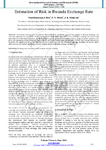Estimation of Risk in Rwanda Exchange Rate
| dc.contributor.author | Dieu, Ntawihebasenga J. | |
| dc.contributor.author | Mwita, Peter N. | |
| dc.contributor.author | Mung’atu, J. K. | |
| dc.date.accessioned | 2019-08-21T07:23:40Z | |
| dc.date.available | 2019-08-21T07:23:40Z | |
| dc.date.issued | 2014 | |
| dc.identifier.issn | 2319-7064 | |
| dc.identifier.uri | http://ir.mksu.ac.ke/handle/123456780/4747 | |
| dc.description.abstract | Generalized Autoregressive Conditional Heteroskedasticity (GARCH) approach was applied to Rwanda Exchange rate returns to estimating current volatility. We fitted autoregressive (AR) model with GARCH errors to the daily exchange rate returns using Quasi-Maximum Likelihood Estimation (Q-MLE) method to get the current volatility and asymptotic properties of the estimators were given. The appropriate GARCH model for each currency was selected using Akaike Information Criterion (AIC). Jarque Bera test for normality was applied and showed that both returns and residuals have fat tails behaviour. Lagrange Multiplier test showed ARCH effects presence in residuals. Results were used to estimate risk in the Rwanda exchange rate process | en_US |
| dc.language.iso | en_US | en_US |
| dc.subject | Exchange rate | en_US |
| dc.subject | Estimation | en_US |
| dc.subject | GARCH model | en_US |
| dc.subject | Risk and Volatility | en_US |
| dc.title | Estimation of Risk in Rwanda Exchange Rate | en_US |
| dc.type | Article | en_US |
Files in this item
This item appears in the following Collection(s)
-
School of Pure and Applied Sciences [259]
Scholarly Articles by Faculty & Students in the School of Pure and Applied Sciences

